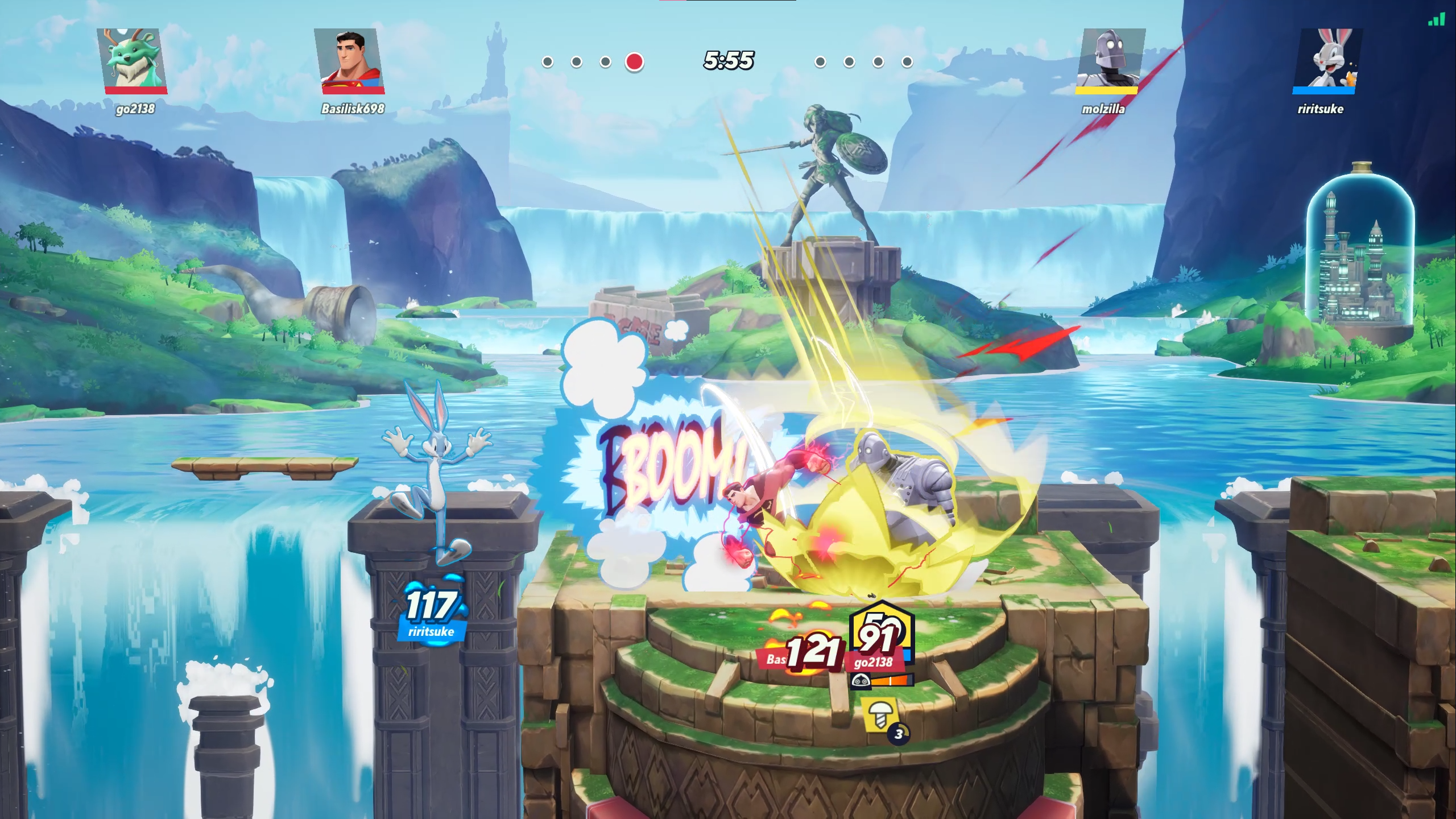Our Verdict
A fun Smash Bros. on PC that needs a little more fine-tuning to reach its full potential.
PC Gamer's got your back
What is it? A platform fighter with an eclectic, iconic cast of characters.
Expect to pay Free-to-play
Release date August 16, 2022
Developer Player First Games
Publisher Warner Bros. Interactive Entertainment
Reviewed on Nvidia GeForce RTX3070, AMD Ryzen 7 2700X, 16GB RAM
Multiplayer? Yes
Link Official site
I'm Adventure Time's Jake the Dog, standing on the edge of a Ricky and Morty-themed arena. I'm about to beat Shaggy from Scooby-Doo into a bloody pulp while my teammate Arya Stark is casually stealing Batman's face. A few years ago this would have given me severe whiplash, but in a world where tennis star Naomi Osaka is throwing hands at Naruto in Fortnite, nothing surprises me anymore. Well, except for one thing: MultiVersus is actually pretty damn good.
Believe me, I never expected it either. The initial reveal left me disinterested—it looked like another weaksauce attempt to be Smash Bros., and I'm not much of a platform fighter gal anyway. I much prefer my fighting games in a tight, enclosed 3D arena a la Tekken and Soulcalibur. I came into MultiVersus not expecting much, yet found that Player First Games have begun to lay the groundwork for something remarkable.
Don't get me wrong, MultiVersus doesn't try to hide its inspiration. Anyone who has spent a modicum of time with Nintendo's brawler will quickly get the gist: smack your opponent with a mixture of normal, air and special attacks in order to increase their damage meter; avoid letting them do the same to you. Victory has nothing to do with getting a health bar from 100 to zero, it's all done through the damage meter. While the number is low, you're weighty and difficult to knock off the top and sides of the arena. As it gets higher though, your character turns into a rubber bouncy ball and becomes susceptible to all kinds of spikes and knockbacks that can fling you straight into the death zone. Knock your opponent out of the arena enough times and you'll claim victory.
Wombo combo
It's your standard platform fighter fare at this point, but MultiVersus manages a few key differences that really set it apart. The first one is how the game handles its roster—every single character is allocated a distinct class: tank, support, mage, bruiser and assassin. Tanks like Wonder Woman and Iron Giant can take more hits and are harder to ring out but are generally slower. Assassins like Finn the Human and Arya Stark are nimble fighters, pulling out every trick in the book to deal big damage quickly.

What's nice is there doesn't feel like any pressure to match up particular classes—you can easily run a team of two supports and successfully outmatch heavy artillery bruisers and tanks if you have the skill. They're a great initial indicator of how you can expect to play each character, but it doesn't feel like any one class is at an inherent disadvantage compared to the others.
There are also the game modes themselves. While other platformers feel more at home in a free-for-all or 1v1 setting, MultiVersus thrives off a 2v2 format. The other two modes are present in the game, but this game was absolutely made for 2v2 and it's where I spent most of my time. Every character has abilities that can support teammates as well as harm foes. Jake the Dog can swallow opponents and spit them out, but he can also quickly chomp an ally and save them from a nasty combo. Wonder Woman's lasso can grab onto opponents but also serve as a quick rescue for teammates.
Killer instinct
It took me a while to get used to the synergy of playing with another person, and to the way MultiVersus feels in general. It's an awful lot floatier than other fighting games I've played—it's lacking a bit of weight, and characters can hover around for what occasionally feels like a lifetime. It starts to feel pretty good once you're in the flow of things though. While I would still like a little more snap, the floatiness feels largely necessary for decent recovery and actually making use of those teammate abilities.
I came into MultiVersus not expecting much, yet found that Player First Games have begun to lay the groundwork for something remarkable.
I had access to the entire roster straightaway, but those coming into it free-to-play will have to work to unlock each one. Thankfully each one is readily available to try out in the training mode free of charge and a regular free character rotation lets you experiment with relative ease. It's also not too much of a slog to reach your first paid character, though subsequent progress slows down.
As I tinkered around with each character, I ended up taking a liking to Iron Giant—he's about twice the size of everyone else and prone to a heavy smackdown, but in return he can dish out big damage and easily shield teammates, allowing them to safely get a fair few hits in on the other team. At first I was an absolute letdown, butt-stomping my way off the map and having my car-swinging shenanigans quickly shut down. But my god, nothing was as satisfying as moments where I could finally land my big shiny metal rear on an opponent, launching them into the air as my teammate jumped and poked them straight out of the arena.
Playing each character also becomes a hell of a lot more fun once you level them up and gain perks. Every game played with a character gives them EXP, and levelling up grants access to unique and shared perks that give you small buffs and extra skills. You can even stack these perks with your teammate for extra benefits, which makes the pre-match setup feel a lot more strategic at higher levels. After I played around enough with Iron Giant, I was given a perk that made his rocket boots leave a trail of fire on the ground. It was a move I hadn't felt much need to use before, but once I was able to scorch my tiny nemeses beneath my feet I found myself integrating it into my play a lot more.
Punching down
There are some glaring frustrations with how MultiVersus plays, though. Hit priority is a mess, a problem that even I could spot at a casual level. For the uninitiated, when two moves connect the priority is generally given to whichever attack has more power. If both attacks hit simultaneously and have a similar power level, they'll cancel each other out. It doesn't seem to be at all present in MultiVersus.
Couple that with what appears to be an odd hitbox and hurtbox system, and it's a pain in the ass to contend with. I noticed this with Finn in particular—his backpack has become a meme, having an oddly gigantic hitbox and causing him to win a lot of matchups he shouldn't. It's worth noting that the hitbox/hurtbox system is already receiving an overhaul, but right now it's a pretty major flaw. Those at a super casual level likely won't perceive it in finer detail, but it was something that became increasingly obvious to me as I spent more time with the game.
I also have some pretty major gripes with the current map designs. There are currently eight stages in MultiVersus, with two of those being variations on another existing map. I had to go and look that up just now, because I can only remember two of the stages: the Scooby-Doo and Rick and Morty ones. The latter I only recall because it was unlocked as part of a community challenge. The Scooby-Doo one, however, has the honour of being my most and least favourite stage. It's the only one I recall having some form of fun interactions—you can punch a wee cog on either side of the arena to cause a portion of the platform to disappear. It's also painstakingly small, bordering on suffocating. It doesn't help that I play a character who is three times the size of the rest of the cast, but larger maps wouldn't go amiss.

Most stages consist of one main platform and then two or three smaller platforms above it. They're fine. But they feel so cramped and uninspired, like being stuck in an elevator made of white bread. There are a couple of wall breaks here and there and they look pretty enough, but they're devoid of the levels of creativity Player First Games has managed to demonstrate through its roster.
Baby steps
Unsurprisingly, MultiVersus is also home to a battle pass. I've never been a fan of them and this one is no different. It's only a short preseason battle pass right now with 15 tiers. There's a nice distribution of rewards throughout the tier, but progression feels unsatisfying. I spent most of my time farming my seasonal milestones, which are randomised per player with no ability to reroll. It meant I was gunning for some ridiculous and unfun goals like ringing out 25 opponents at less than 60 damage or connecting 200 fully charged attacks. More battle pass points per match would go a long way, along with the ability to reroll some more frustrating milestones outside of my skill level.
As it stands, MultiVersus has done a bang-up job of laying the foundations for a fantastic platform fighter that has the potential to blossom into something amazing. Killer backpacks and janky hitboxes aside, each character is brimming with personality and movesets that never feel too out-of-character. It's definitely helped by the fact that Warner Bros. was able to recruit a ton of the cast's original voice actors, something that you don't see very often. It's a game not without its teething problems though—until hitbox and hit priorities are set straight, MultiVersus will continue to fall flat for people at a higher skill level. But for a game still technically in open beta, MultiVersus is a worthy competitor in the platform fighter genre.
A fun Smash Bros. on PC that needs a little more fine-tuning to reach its full potential.

Mollie spent her early childhood deeply invested in games like Killer Instinct, Toontown and Audition Online, which continue to form the pillars of her personality today. She joined PC Gamer in 2020 as a news writer and now lends her expertise to write a wealth of features, guides and reviews with a dash of chaos. She can often be found causing mischief in Final Fantasy 14, using those experiences to write neat things about her favourite MMO. When she's not staring at her bunny girl she can be found sweating out rhythm games, pretending to be good at fighting games or spending far too much money at her local arcade.


